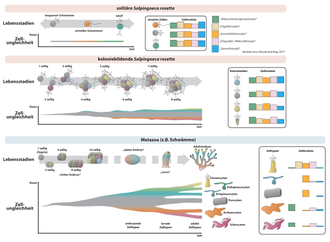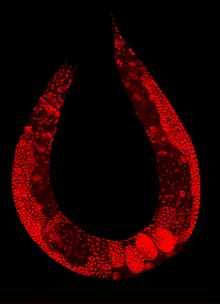Multi-cell
Multicellular or multicellular organisms are living beings , consisting of a plurality of cells are constructed. True multicellular cells differ from colonies of unicellular organisms in that they share a common metabolism of the cell structure, a more or less pronounced division of tasks between the cells and often the formation of tissues . A boundary between true multicellular cells and single cell colonies with a certain degree of differentiation is not precisely defined.
Multicellular organisms include the majority of animals (Animalia), plants (Plantae) and fungi (Fungi). These were compared by Ernst Mayr as metabionta with the unicellular protists and bacteria (at that time still the archaea with comprehensive, according to the more modern term prokaryotes ). These two groups, however, only form organizational levels and not related groups ( clades ), since multicellularity has arisen several times independently of each other and some prostists are more closely related to animals, plants or fungi than they are to each other. In addition, there are transitional forms to multicellularity in various groups of algae , protozoa , fungi and partly also in bacteria (bacteria).
Evolution of multicellularity

Multicellularity evidently emerged independently several times in the course of evolution . The oldest known fossil multicellular organisms appeared about 2 to 3 billion years ago in the Proterozoic . These were to Trichom producing microorganisms, which are believed that cyanobacteria were and simple green algae . More complex multicellular organisms may appear for the first time 2.1 billion years ago ( Gabonionta ) and relatively certain about 600 million years ago in the Neoproterozoic with the Ediacara fauna and the earliest multicellular animals (Metazoa). RA Jörres (2010) discusses a model analysis of the formation of multicellular organisms that are differentiated by division of labor.
In addition to the clearly identifiable single and multicellular cells, there are still various transitional forms. In some species, transitions from single to multicellularity can also be observed depending on environmental conditions:
- Different bacteria, especially within the cyanobacteria (outdated “blue-green algae”) form complex structures from several cells, which can contain a common mucous membrane and specialized cells (e.g. spores or nutrient-storing cells). Other examples include a. the Actinomycetales (outdated "ray mushrooms") and the fruiting body-forming myxobacteria .
- Different algae form colonies with a tendency to cell differentiation. Generally, a distinction is made in the Botany in multicellular algae and plants shapes with a relatively poorly differentiated multicellular physique of the thallus is referred to, and the subdivided into clearly differentiated tissues and organs corms .
- Some of the "protozoa" from the group of choanoflagellates , considered to be the closest relatives of the multicellular animals (Metazoa), form small rosette-shaped colonies under certain conditions, in which a slight cell differentiation, which increases with the size of the colony, was found.
- In some types of fungus, both unicellular yeast and multicellular hyphae phases are found.
- In cellular slime molds such as Dictyostelium discoideum, individually living cells aggregate to a fruiting body when there is a lack of food, within which cell differentiation occurs.
Biochemical and molecular requirements of multicellularity
The prerequisites for multicellularity - they are reflected down to the molecular level - result from the solution of specific problems. So the problem of the communication of the interconnected cell or tissue associations has to be solved, the direct cell-cell communication, the cell differentiation, the most different cell types have to be coordinated and formed from undifferentiated progenitor cells. The cell adhesion , the cells of the individual tissues and organs of the organism have to adhere to one another in a certain way so that they can develop a shape.
Intercellular recognition processes are one of the fundamental processes in the development of multicellular organisms. But they are also of great importance for the maintenance of tissues and for regeneration processes in adult organisms. Part of these morphoregulatory processes is the membrane-dependent conversion of intercellular recognition into signal processes . Thus, the cell hikes , such as from somites into the limb systems, the differentiation of cells, such as the polarization of epithelial cells, and (in specific cell context, the fate of cells stem cell development) influences.
Reproduction and death
While unicellular organisms reproduce through simple cell division , most multicellular organisms have more complex reproductive strategies. In particular, in addition to the somatic cells that build up the functional organism (somatic cells), they often have specialized cells that serve to produce the next generation (generative cells). These can be formed sexually ( sex cells ) or asexually .
In 1881 August Weismann hypothesized that aging and mortality only occurred in the course of the evolution of multicellular organisms. In the unicellular organism, the individual cell also serves as a generative cell which, through division, produces the next generation, so that the entire unicellular organism is potentially immortal . In the case of the multicellular organism, this potential immortality is limited to the generative cells, while the body made up of the somatic cells and defining the individual is mortal.
See also
literature
- Neil A. Campbell: Biology. Spectrum textbook, 6th edition, edited by J. Markl, Spektrum Verlag, Heidelberg, Berlin 2003, ISBN 3-8274-1352-4 .
- Peter H. Raven, Ray F. Evert, Susan E. Eichhorn: Biology of plants. Walter de Gruyter, Berlin, New York 2000, ISBN 3-11-015462-5 .
- WA Müller, M. Hassel: Developmental Biology. Springer, Heidelberg 1999, ISBN 3-540-65867-X .
- Minelli, Alessandro: Forms of Becoming: The Evolutionary Biology of Development. Princeton University Press, 2009, ISBN 0-691-13568-1 .
- Minelli, Alessandro: Perspectives in Animal Phylogeny and Evolution. Oxford Univ. Press, 2008, ISBN 0-19-856621-2 .
Individual evidence
- ↑ a b c RK Grosberg, RR Strathmann: The evolution of multicellularity: A minor major transition? . In: Annu Rev Ecol Evol Syst . 38, 2007, pp. 621-654. doi : 10.1146 / annurev.ecolsys.36.102403.114735 .
- ^ RA Jörres: Development of multi-cellular organisms differentiated by division of labor through selection: A model analysis . 2010, [1]
- ^ Benjamin Naumann, Pawel Burkhardt: Spatial cell disparity in the colonial choanoflagellate Salpingoeca rosetta. Frontiers in Cell and Developmental Biology. Vol. 7, 2019, item no. 231, doi: 10.3389 / fcell.2019.00231
- ↑ Sebé-Pedrós, Arnau; Ruiz-Trillo, Iñaki: Integrin-mediated adhesion complex. Co-option of signaling systems at the dawn of Metazoa. Communicative & Integrative Biology 3: 5, 475-477; September / October 2010, doi : 10.4161 / cib.3.5.12603 , PMC 2974085 (free full text)
- ^ Marks, Friedrich; Klingmüller, Ursula; Müller-Decker, Karin: Cellular Signal Processing: An Introduction to the Molecular Mechanisms of Signal Transduction. Taylor & Francis, New York 2008, pp. 117, ISBN 0-8153-4215-2 .
